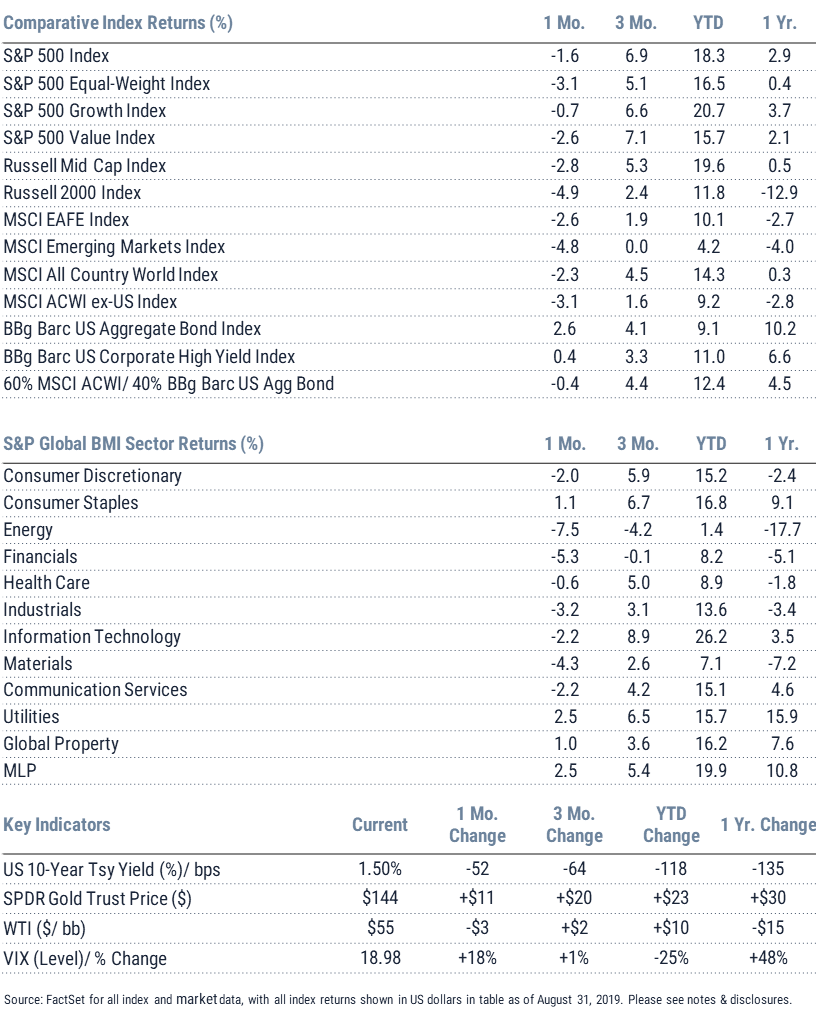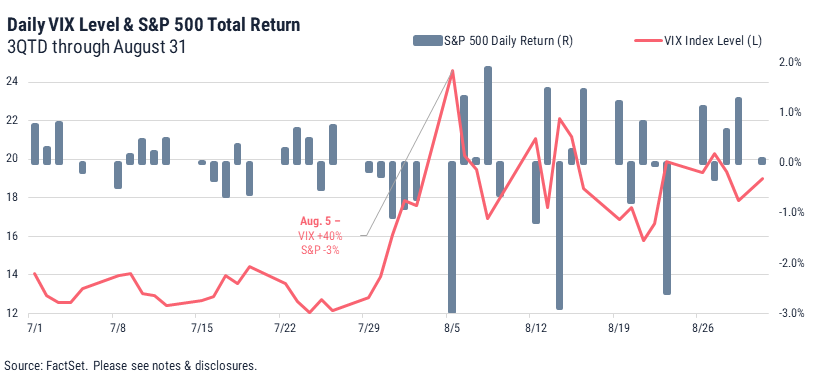August 2019 - Global Equity Market Review
Following an overall positive result in a quiet July, August saw volatility uncorked and equity markets capitulate as the US-China Trade War escalated and investors connected the dots between worrying aspects of the global macro picture.

The month’s day-to-day progress seemed to reflect a mix of profit-taking and more decisive risk-off selling as investors weighed the adequacy of a Fed-led global monetary pivot against mounting pressure from various trade skirmishes and structural headwinds globally. Investors reacted, further, to the US 10-year yield slipping below the 2-year (the first such observation since 2007) and, separately, the Chinese government moving to devalue its currency through lending rate reform, leading the US to label the country a currency manipulator. Bonds rallied and the US 30-year Treasury notched an all-time closing low, dipping below 2%. All said, global stocks fell 2.3%, led lower by emerging markets (-4.8%), while US equities outperformed (-1.6% as measured by the S&P 500).
As shown in the below chart, from a trading perspective August’s result was less of a gradual slide than it was a ping-pong match between short-term support and resistance; 11 of the month’s 22 trading sessions closed up or down 1% or greater (16 saw intra-day moves greater than 1%), and the S&P averaged (in absolute terms) a daily move of 1.11%. The CBOE VIX Index – or so-called “Fear Index” – on August 5th hit 25, roughly the level seen in an October 2018 sell-off that preceded a more comprehensive meltdown in December.

While the month’s result clearly articulated pain points relative to the US-China Trade War (Energy, Industrials and Materials were among worst-performing sectors), US stocks fared better than international peers. Large-cap growth companies experienced relatively modest losses (-70 basis points) and that segment pulled past mid cap into market-leading status for 2019. Mid caps shared in the risk-off pressure on smaller names and the underperformance of smaller names even in positive or outperforming sectors (such as Real Estate). Small cap (-4.9% for the Russell 2000) brought up the rear within domestic equity. Consistent with the structural pressure on smaller size and value characteristics, equal-weight (-3.1%) badly underperformed market-weight.
Ex-US stocks overall shed 3.1% during the month, faring worse in dollar than in local currency terms (-2.3%) as the USD strengthened against most currencies, including a devalued Chinese renminbi, struggling Indian rupee, sliding Brazilian Real and free-falling Argentine peso. Developed international stocks, as measured by the MSCI EAFE, posted -2.6% for the month in USD terms and -2.4% in local terms, as Japanese Yen appreciation hedged some of the drag. Hong Kong, roughly 4% of the EAFE index, fell roughly 8% during a month marked by at times-convulsive pro-democracy protests. Currency impacts cost the MSCI Emerging Markets Index around 240 basis points as it shed 4.9% in USD versus 2.5% in local; the Brazilian USD/ local performance spread was nearly 900 basis points.
Notes & Disclosures
Index Returns – all shown in US dollars
All returns shown trailing 8/31/2019 for the period indicated. “YTD” refers to the total return as of prior-year end, while the other returns are annualized. 3-month and annualized returns are shown for:
- The S&P 500 index is comprised of large capitalized companies across many sectors and is generally regarded as representative of US stock market and is provided in this presentation in that regard only.
- The S&P 500® Equal Weight Index (EWI) is the equal-weight version of the widely-used S&P 500. The index includes the same constituents as the capitalization weighted S&P 500, but each company in the S&P 500 EWI is allocated a fixed weight - or 0.2% of the index total at each quarterly rebalance. The S&P 500 equal-weight index (S&P 500 EWI) series imposes equal weights on the index constituents included in the S&P 500 that are classified in the respective GICS® sector.
- The S&P 500 Growth Index is comprised of equities from the S&P 500 that exhibit strong growth characteristics and is weighted by market-capitalization.
- The S&P 500 Value Index is a market-capitalization weighted index comprising of equities from the S&P 500 that exhibit strong value characteristics such as book value to price ratio, cash flow to price ratio, sales to price ratio, and dividend yield.
- The Russell 3000 Index tracks the performance of 3000 U.S. corporations, determined by market-capitalization, and represents 98% of the investable equity market in the United States.
- The Russell Mid Cap Index measures the mid-cap segment performance of the U.S. equity market and is comprised of approximately 800 of the smallest securities based on current index membership and their market capitalization.
- The Russell Micro Cap Index is a market-capitalization weighted index that measures the performance of 2000 small-cap and mid-cap securities. The index was formulated to give investors an unbiased collection of the smallest tradable equities still meeting exchange listing requirements.
- The MSCI All Country World Index provides a measure of performance for the equity market throughout the world and is a free float-adjusted market capitalization weighted index.
- The MSCI EAFE Index is a market-capitalization weighted index and tracks the performance of small to large-cap equities in developed markets of Europe, Australasia, and the Far East.
- The MSCI Emerging Markets Index is a float-adjusted market-capitalization index that measures equity market performance in global emerging markets and cannot be purchased directly by investors.
- The S&P Global BMI sector indices are into sectors as defined by the widely used Global Industry Classification Standards (GICS) classifications. Each sector index comprises those companies included in the S&P Global BMI that are classified as members of respective GICS® sector. The S&P Global BMI Indices were introduced to provide a comprehensive benchmarking system for global equity investors. The S&P Global BMI is comprised of the S&P Emerging BMI and the S&P Developed BMI. It covers approximately 10,000 companies in 46 countries. To be considered for inclusion in the index, all listed stocks within the constituent country must have a float market capitalization of at least $100 million. For a country to be admitted, it must be politically stable and have legal property rights and procedures, among other criteria.
- The Barclay’s US Aggregate Index, a broad based unmanaged bond index that is generally considered to be representative of the performance of the investment grade, US dollar-denominated, fixed-rate taxable bond market.
- The Bloomberg Barclay’s US Corporate High Yield Index, which covers the USD-denominated, non-investment grade, fixed-rate, taxable corporate bond market.
Key Indicators
Key Indicators correspond to various macro-economic and rate-related data points that we consider impactful to equity markets.
- The US 10-Year Treasury Yield (%)/bps, is the return on investment for the U.S. government’s 10-year debt obligation and serves as a signal for investor confidence.
- SPDR Gold Trust Price ($), is an investment fund that reflects the performance on the price of a gold bullion, less the Trust’s expenses.
- West Texas Intermediate, which is an oil benchmark and the underlying asset in the New York Mercantile Exchange’s oil futures contract.
- CBOE Volatility Index (Level)/% Change, which uses price options on the S&P 500 to estimate the market's expectation of 30-day volatility.
This document is intended for informational purposes only and should not be otherwise disseminated to other third parties. Past performance or results should not be taken as an indication or guarantee of future performance or results, and no representation or warranty, express or implied is made regarding future performance or results. This document does not constitute an offer to sell, or a solicitation of an offer to purchase, any security, future or other financial instrument or product. This material is proprietary and being provided on a confidential basis, and may not be reproduced, transferred or distributed in any form without prior written permission from WST. WST reserves the right at any time and without notice to change, amend, or cease publication of the information. This material has been prepared solely for informative purposes. The information contained herein includes information that has been obtained from third party sources and has not been independently verified. It is made available on an "as is" basis without warranty and does not represent the performance of any specific investment strategy.
We consider an index to be a portfolio of securities whose composition and proportions are derived from a rules-based model. See the appropriate disclosures regarding models, indices and the related performance. You cannot invest directly in an index and the performance of an index does not represent the performance of any specific investment. Some of the information enclosed may represent opinions of WST and are subject to change from time to time and do not constitute a recommendation to purchase and sale any security nor to engage in any particular investment strategy.
Past performance or results should not be taken as an indication or guarantee of future performance or results, and no representation or warranty, express or implied is made regarding future performance or results.
Besides attributed information, this material is proprietary and may not be reproduced, transferred or distributed in any form without prior written permission from WST. WST reserves the right at any time and without notice to change, amend, or cease publication of the information. This material has been prepared solely for informative purposes. The information contained herein may include information that has been obtained from third party sources and has not been independently verified. It is made available on an “as is” basis without warranty. This document is intended for clients for informational purposes only and should not be otherwise disseminated to other third parties. Past performance or results should not be taken as an indication or guarantee of future performance or results, and no representation or warranty, express or implied is made regarding future performance or results. This document does not constitute an offer to sell, or a solicitation of an offer to purchase, any security, future or other financial instrument or product.
